Another fun post from our daughter, Charli, AKA The Piglet!
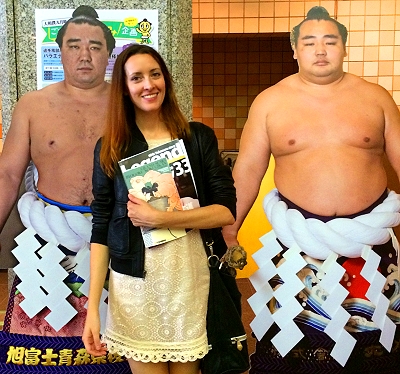
There’s a misconception that sumo wresting is just a couple fat dudes bashing into each other, but there’s actually a lot ritual, a lot of skill, and a lot of training that goes into those fat guys bashing into each other.
Sumo tournaments are held three times a year in Tokyo and I was lucky enough to be in town during this year’s September matches.
Japan’s national sport is held at Ryogoku Kokugikan where more than 11,000 spectators cheer on (and sometimes get crushed by) their favorite competitors.
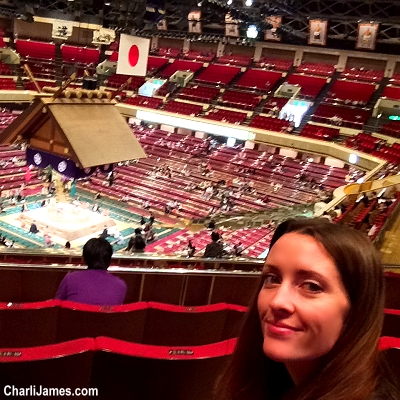
The fights are much more intense than I ever expected.
The tournament runs from morning until 6pm, with the best fighters at the end, and though each match generally lasts only a minute or less (the best go longer), you’re on the edge of your seat.
Wrestlers are often hurled out of the ring, landing on the judges and fans lucky enough (and brave enough) to occupy the ringside seats.
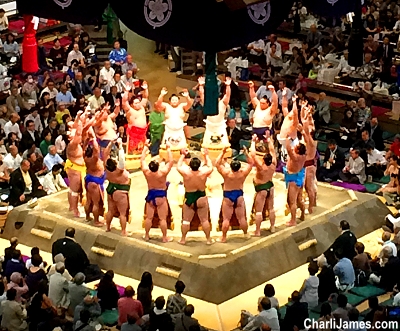
There’s a lot of ritual at the tournaments too. Wrestlers throw salt to purify spirits, announcers sing out the competitor’s names to begin the match, and wrestlers peacock in the ring lifting their legs high and slapping their muscles.
The minutes in the ring before the match are when wrestlers have a chance to show their personality and intimate their opponent.
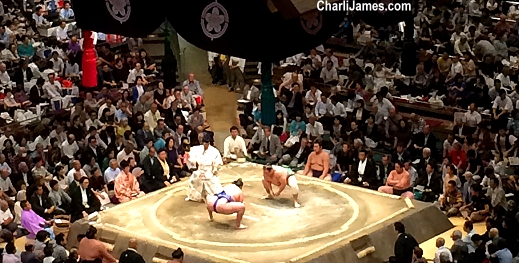
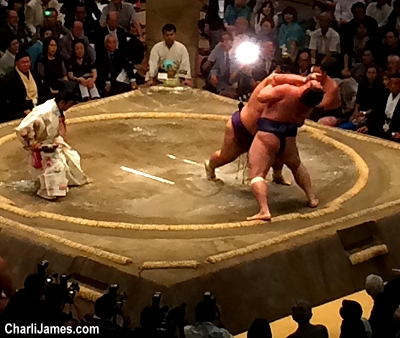
Ringside seats are Japanese box style, where you sit on a cushion on the floor; the ticket website warns “There is the danger of suffering injuries due to falls from the ring by wrestlers and other participants.”
Totally worth the risk of crushing in my opinion.
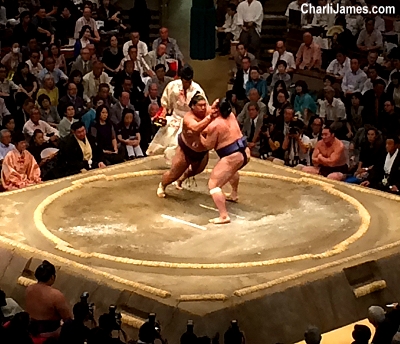
I was up on the second level in the “western style” seats, similar to what is typically found in an American stadium.
While the best seats sell out far in advance, the very top level seats are reserved for the morning of the matches and only sold at the stadium.
Before going, I watched a documentary called A Normal Life. Chronicle of a Sumo Wrestler that follows Takuya Ogushi, a recent high school graduate who enters a sumo stable in Tokyo, through his first year of training and matches.
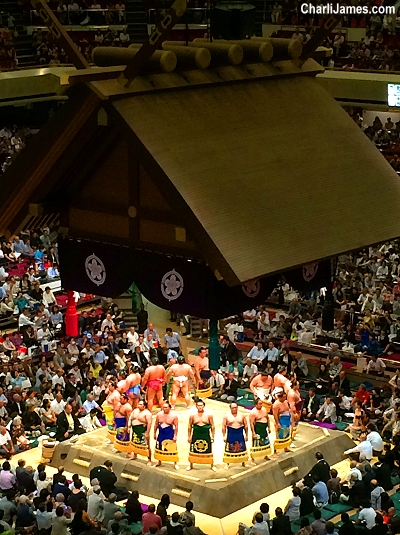
These modern warriors eat (a lot), sleep, train and play together, forming a bond more like brothers than teammates. I watched as Takuya Ogushi put on 90 pounds and gained respect for the heart it takes to make it as a sumo wrestler.
I strongly recommend you watch before going to get a background on what these athletes do to succeed.
At the match, I rented a radio that feeds English commentary for the two hours of the highest-level matches. Learning about each wrestler’s background, styles and fan bases really adds to the experience.
My favorites were a 21-year-old Mongolian wrestler named Ichinojo who is kicking butt in his first season in the highest bracket. And another named Endo who, while his record isn’t stellar, is apparently quite the ladies man—he draws scores of female fans who love his “sweet exterior,” according to the radio commentator.
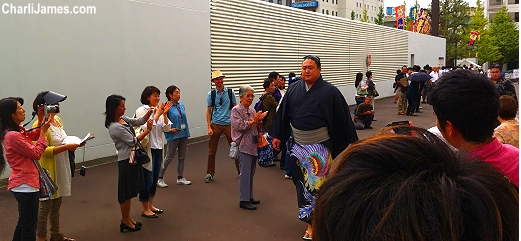
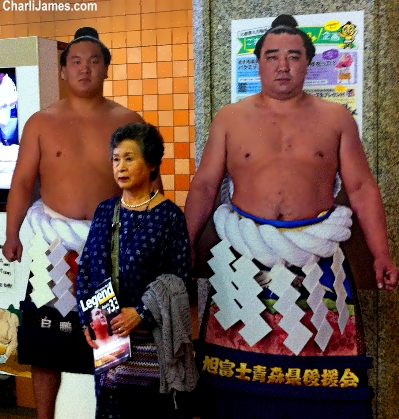
Another fun part of the experience is watching the wrestlers arrive at the stadium.
Fans line up along the route from the street to the stadium and are able to get close and root on their favorites.
Watching old ladies losing it over being close to a giant wrestler is pretty great.
And because it wouldn’t be a GypsyNester post without a mention of food, there are a few stadium treats of note. I started off with a box of Takoyaki, aka octopus balls.
Whole wheat batter surrounds minced octopus, pickled ginger and cabbage and the balls are covered in mayo and spicy sauce.
Next, I’d suggest a bowl of tasty chankonabe or sumo wrestler stew, which is a protein-heavy soup eaten by competitors in huge quantities to bulk up. Finally, I fulfilled my sumo-sized meal with a tasty green tea ice cream cone.
If you’re planning a trip to Tokyo, don’t miss this truly Japanese experience.
And be sure to let us know if you are lucky enough to get crushed!
Charli
Have any questions for me? You can email me, or tweet me at @charli and follow my travels too!


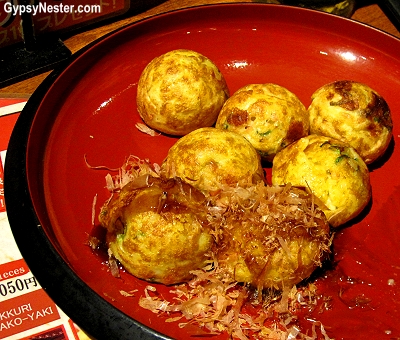

I totally agree with the author’s ideas. This is a great piece of writing.
Thanks for the great post Piglet! Love you.
I’ve never really much thought to Sumo wrestling, but you’ve got my interest. Love all the info about tradition and rituals. Attending a tournament in Tokyo would be very cool, but I’d pass on the ringside seats.
ok! sumo wrestling is now on my to-do list when I finally visit Tokyo.
I’d never thought about watching sumo wrestlers live, but this looks like so much fun! I want to go to Tokyo.
The words are great but the pictures are priceless!:-)
Super pix, and fascinating information. Sumo Wrestler Stew! Who knew! Thanks for the new perspective on ‘down time’ in Japan. 🙂
Such a great post! We were just talking about Sumo Wrestlers last night at a wine tasting. There is a tremendous amount of training and culture respect around this sport. They also have many rituals around their meals. Thanks so much for sharing the story.
Definitely something to experience now you come to mention it 😉 How interesting 🙂 Hmmm, would also steer clear of a front row seat for fear of potentially being squashed by a flying Sumo.
I say I would want to sit up there, but you’re probably right, the idea of a 400lb wrestler flying at you is more fun in theory than in reality!
A very Japanese experience for sure! I do like those takoyaki balls, I think it’s the tasty sauce.
I would have been in the second tier too—with the other gaijin. There’s the fear of being crushed thing, but also based on few sitting on floor cushions meals I had when we visited Japan, I’d prefer to have some feeling (sensation) left in my legs after the matches.
Preparation for a sumo match is a great idea. My misconception is aligned with what you outligned. What a great way to get a sense of the culture and good to hear you can listen to the matches in English.
I once watched a documentary about Sumo and there was mention of match fixing and wrestlers undergoing regular beatings during training. Sad that something so cultural and ritualistic would be drenched in scandal.
Yes, I’ve heard of problems with hazing and gambling in Sumo as well– there was even one young wrestler who died a few years ago from injuries sustained at his stable. I’ve read the governing organization is working to try and change this culture, especially since the sport carries so much cultural significance in Japan too.
Glad to hear they’re trying to change that.
Its quite a rare spectacle then being only 3 times a year – Definitely a must if you’re lucky enough to be in town when it happens – Your photos are excellent 🙂
Yes! It’s three times a year in Tokyo, but there are three other tournaments in other cities across Japan–six total. Thanks for the compliment on the photos 🙂
Great pictures! Wow, the idea of a sumo wrestler being hurled into the audience would definitely keep me from a front row seat!!
Wow! As an ignorant westerner I never thought about the history, ritual or the difficult training that go into becoming a Sumo wrestler. Thanks for writing this informative post. Now I want to do some reading about this sport (and hopefully attend a match someday).
I was really surprised too! I didn’t know much before deciding to go to the tournament– but I was very impressed with how interesting and entertaining it was.
I’m not sure I’d be willing to risk a ringside seat to watch the Sumo Wrestlers ( I imagine they would be very pricey tickets too) but going to a Sumo Wrestling match sounds like a fascinating way to experience Japanese culture.
The best ringside seats are around $150– pricy, but I actually was surprised they weren’t more considering how popular the tournament is.
Interesting post.I didn’t realize there was that much involved in sumo wrestling.
The quintessential Japanese ritual! How fascinating it would be to attend one of these matches. Thanks for bringing us along and explaining some of the nuances.
One of my bucket list items for when I get to Japan … thanks for the preview!